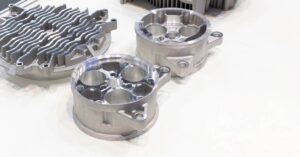Die casting, one of the oldest forms of manufacturing, remains at the forefront of the production world because of its unmatched ability to create consistent and precise parts. So, what makes this manufacturing method so precise?
Factors Ensuring Precision in Die Casting
- Mold Design & Quality – The mold, often made from hardened steel, dictates the final shape and features of the part. Expert engineers craft these molds, ensuring every micro-detail is perfect. High-quality molds maintain their shape and integrity even after thousands of casts.
- Material consistency – By maintaining a consistent molten metal temperature, die casting machines can ensure that each batch has the same material properties. This results in parts with consistent strength, weight, and durability.
- Precision machinery – Modern die casting machines are equipped with sophisticated sensors and controls, allowing for precise regulation of parameters like pressure and temperature, further enhancing accuracy.
Understanding the Consistency Factor
Imagine producing a batch of 10,000 parts and realizing that there’s a variance between part 1 and part 10,000. This could be disastrous for industries where even a millimeter off can compromise safety or functionality. That’s where die casting shines.
- Uniform production – The process is so consistent that, barring any unforeseen complications, every part from the first to the last will look and feel identical.
- Rapid turnaround – Not only does die casting produce consistent results, but it does so quickly. Depending on the complexity and size of the part, you can produce thousands within an hour.
A Step-by-Step Glimpse into the Process
- Mold preparation – Before casting begins, the two halves of the mold are cleaned and prepped, ensuring no remnants from the previous casting can interfere.
- Molten metal – Metal alloys are heated until they turn molten. It’s crucial that the temperature is monitored to ensure consistency.
- Injection – The molten metal is then rapidly injected into the mold under high pressure. This pressure ensures the metal fills every nook and cranny of the mold.
- Cooling & solidification – Once injected, the metal begins to cool and solidify. This phase is critical; cooling too quickly or unevenly can cause inconsistencies.
- Ejection – After the metal has solidified, the mold halves are opened, and the newly formed part is ejected, ready for any post-processing if required.
While these steps may seem simple, the precision and control maintained at every stage make die casting reliable for consistent, high-quality production.
The Real-World Impact
Consider industries like aerospace, automotive, and medical equipment. In these fields:
- Safety is paramount – A faulty car brake component or an inconsistent part in an airplane can lead to dire consequences. With die casting, industries can trust the consistency of every part.
- Longevity matters – Repeated use of parts, like those in daily machinery or vehicles, requires durability. The consistency achieved in die casting ensures parts wear evenly, extending their lifespan.
The list of industries that rely on the precision of die casting is vast. From everyday gadgets to critical life-saving equipment, the impact of die casting precision can be seen everywhere.
Advancements in Die Casting
The world of die casting is not stagnant. It involves continuous research, development, and innovation. Let’s peek into the latest advancements that have further elevated the precision and consistency of die casting.
- Simulation technology – Before casting, computer-aided simulations can predict how the molten metal will flow, identifying potential air pockets or weak spots. This allows for design adjustments before the production begins, ensuring optimal casting conditions.
- Vacuum-assisted casting – Introducing a vacuum during the casting process helps reduce porosity and improve the structural integrity of the parts. Fewer imperfections mean higher quality and consistency.
- Robotic automation – Integration of robotics ensures repetitive tasks are executed with unmatched consistency, reducing human error. This also expedites production timelines.
The Future of Precision in Die Casting
What does the future hold? With the onset of Industry 5.0, the lines between physical production and digital technology are blurring.
- Smart factories – The next generation of casting will see factories with interconnected machinery, AI-driven analytics, and predictive maintenance.
- Customization – The ability to produce custom, one-off pieces with the same efficiency and precision as bulk orders will revolutionize sectors like medical implants, automotive customization, and more.
- Sustainability – As with many industries, the push for greener, more sustainable practices will drive innovation. We can expect to see more recycled materials, energy-efficient processes, and reduced emissions.
In Conclusion
Precision in production isn’t just a buzzword; it’s a necessity, especially in today’s fast-paced, quality-driven world. Die casting, with its roots deep in history, continues to evolve, adapt, and lead as a testament to its unmatched prowess in ensuring accuracy and consistency. From the intricate parts in our pocket-sized gadgets to the robust components in our vehicles, the precision of die casting touches our lives daily. As we look forward, there’s immense excitement about where this blend of art and science will take us next.






